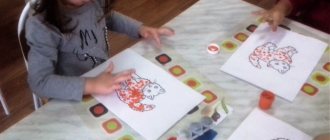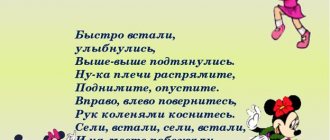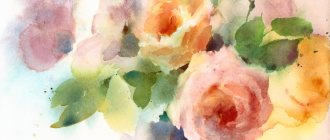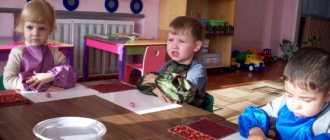Summary of the drawing lesson “Pet - cow” in the preparatory group
Elena Belkova
Summary of the drawing lesson “Pet - cow” in the preparatory group
MUNICIPAL BUDGETARY PRESCHOOL EDUCATIONAL INSTITUTION "KINDERGARTEN OF GENERAL DEVELOPMENTAL TYPE No. 21"
Abstract
On direct educational activities in the preparatory group FIREFLY .
Artistic creativity ( drawing )
On the topic: Pets cow
Prepared by the teacher
Materials and equipment:
1. Demonstration: photo of a cow with a calf
2. Handout: For each child, a piece of paper, pencils.
Looking at an illustration on the theme Cow in the meadow .
Purpose of the lesson : To consolidate and expand children’s ideas about domestic animals and the features of their appearance.
Learn to draw a cow , continue to develop the ability to think through the compositional construction of an image, continue to learn how to mix paints, develop imagination and memory.
Preview:
Summary of a lesson in visual arts using an unconventional drawing technique - painting with sponges.
Topic: “Pets are our friends”
Goals: To introduce a new type of unconventional drawing technique - painting with a sponge.
Cultivate observation and a kind attitude towards pets.
Introduce a new genre of painting – animalistic.
Develop creativity, imagination, independence
Materials and equipment: pictures of cats; album sheets of paper, gouache, palette, brushes, sponges for drawing.
1 . Conversation on the topic “pets”.
2. Observation of pets, cats, on walks, at home;
3. Looking at illustrations of pictures with cats;
4. Reading poems, fairy tales;
5. Watching cartoons “Tom and Jerry”, “Leopold the Cat”.
Integration of educational areas: cognition, socio-communicative development, speech development.
Educator: Children, today we will have an art lesson.
Let's first remember what genres of painting you know.
Paintings depicting nature are called Landscape.
Paintings depicting beautiful things and objects are called still life.
Drawing a person's face is a genre of Portraiture.
Today we will get acquainted with a new genre of painting - Animalistic.
Educator: Remember, guys, if any animal is drawn in the picture, then this is an animalistic genre. The word animal means animal in English. Therefore, artists who draw animals are called animal painters.
Educator: At all times, people loved, tamed animals, observed them, and reflected their observations in works of art: paintings, book illustrations, sculptures, frescoes, painting of household items. Today we will be animal artists. If you guess the riddle, you will find out who we will draw.
Progress of the lesson
1. Organizational part
1st child. Picture a dog barking.
2nd child. Picture a cat meowing.
3rd child. Like a cow mooing .
4th child. Oh, how a horse neighs.
5th child. Like a pig grunting.
Teacher. Right. Why are these animals called pets ? Children. They live next to a person who takes care of them.
Teacher. Right. But these animals were not always domestic . They once lived in the wild. How did man manage to tame them? When ancient people hunted, they brought home from the hunt not only the prey they killed, but also young animals - piglets, calves, kids. Children played with them, the animals gradually became tame, the tamed animals ceased to be afraid of people, they got used to receiving food and protection from them. In turn, they also became useful to humans: they provided milk, wool, meat; helped a person in hunting and guarded his home.
Teacher. You know how animals , now try to guess the animals using riddles .
2. Soft paws, and scratchy paws. (Cat.)
3. I won’t let a stranger into the house, I’m sad without the owner - Woof-woof-woof! (Dog.)
Teacher: Well done, they named everyone correctly.
Now guess another riddle:
They kicked out the antlers for a walk in the meadows. And the horns arrived in the evening with milk.
Children: It's a cow !
of cows grazes in a steamy water meadow near the river .
's body is wide , with rounded swollen sides, short , a long strong tail resembles a panicle - with it Burenushka drives away annoying flies. The cow has a large head with upturned horns, erect ears with which she can hear well, and large dark brown velvety eyes. have an excellent sense of smell : but by smell they can easily distinguish edible herbs from inedible ones.
Cows are herbivores . They are slow and calm. Cows walk slowly , with their heavy heads down, nibbling on the grass. First, Burenka deftly grabs the ladder with his tongue, and then jerks his head and tears it off.
Teacher: What benefits do you think cows bring to people ?
That's right, they give us milk and meat. People have learned to prepare many healthy, tasty and nutritious foods from milk. The people have composed many proverbs and sayings dedicated to the cow , in which they lovingly call the cow “nurse”
, “
Mother Cow* and “Burenushka”
. Here are some of them:
“If there was
a cow , there would be milk” ,
“
A cow in the yard means food on the table” ,
a cow
in the yard , you will be fed and clothed” .
2. Practical part.
Teacher: today we will depict a cow walking in a meadow. Let's start drawing with the torso . It looks like an oval. Then we draw a round head. The head has an oval muzzle. On the face there is a nose and mouth. There are also ears and horns on the head. For our cow to see grass , she needs eyes. Now our cow needs to draw legs - at the ends of which there are hooves. We also need a tail so that our cow can drive away flies .
In order for a cow to produce milk , she needs an udder. What a beautiful cow we have ! A cow grazes on a wide , green meadow. The warm sun shines on her from above. Somewhere in the distance, in a village, a kind mistress is waiting for her.
Teacher: Now our cows will all gather into a herd. Children hang their work on the board. The teacher asks the child to give his cow and tell what her character is.
Summary of the entertainment “Burenka the Cow Visiting the Children” in the middle group Goal: consolidate knowledge about milk and dairy products, develop musical abilities and communication skills. Progress of entertainment. (IN.
Summary of a lesson in non-traditional drawing techniques in the senior group “My favorite animal” Purpose: To learn to expressively convey images of animals in drawing (body shape, location and shape of body parts, their size, proportions) with support.
Lesson summary for the senior group “My favorite pet” Contents of the software: Learn to convey images of pets (body shape, location and shape of parts.
Summary of a drawing lesson in the senior group on the topic “Cow”
Anna Demushkina
Summary of a drawing lesson in the senior group on the topic “Cow”
Topic: Drawing a cow.
Goal: teach children to draw a cow , building an image from its component parts.
consolidate and expand children’s ideas about domestic animals and the features of their appearance;
develop the ability to think through the compositional construction of an image, imagination, memory;
cultivate a caring attitude towards animals.
On the topic: methodological developments, presentations and notes
“Our Little Friends” is a lesson to familiarize yourself with the world around you. The goal is to promote the formation of an interested, caring attitude towards pets. Tasks: form.
This presentation contains layouts for simplified drawing of domestic animals: horse, cow, dog, etc. and birds.
Goals and objectives. Teach children to do work using the sponge painting technique. Reinforce knowledge about color and paint properties. Develop children's creative abilities. Introduce family representatives.
Introduce a new type of unconventional drawing - painting with sponges. Acquaintance with a new genre of drawing - animalistic. Cultivate a kind attitude towards pets.
In this master class I will show you how you can draw a “Flower Meadow” using an ordinary dish sponge and cotton swabs.
GCD summary for drawing. Topic: Pets.
DRAWING NODE “Portrait of a Pet”.
Progress of the lesson.
1. Organizational part
Guys, try to guess the animals from the riddles.
2. Soft paws, and there are scratches in the paws. (Cat.)
3. I won’t let a stranger into the house, I’m sad without the owner - Woof-woof-woof! (Dog.)
Well done, they named everyone correctly.
What other pets do you know?
Why are these animals called pets? They live next to a person who takes care of them.
Right. But these animals were not always domestic. They once lived in the wild. How did man manage to tame them? When ancient people hunted, they brought home from the hunt not only the prey they killed, but also young animals - piglets, calves, kids. Children played with them, the animals gradually became tame, the tamed animals ceased to be afraid of people, and became accustomed to receiving food and protection from them.
In turn, they also became useful to humans: they provided milk, wool, meat; helped a person in hunting and guarded his home.
How can you explain the meaning of the proverb:
“ A cow in the yard means food on the table”
That's right, they give us milk and meat. People have learned to prepare many healthy, tasty and nutritious foods from milk.
to draw a cow today ?
draw it correctly and beautifully, you need to carefully examine it. What parts does a cow consist of and what do they look like ?
's body is wide , with rounded swollen sides, short , a long strong tail resembles a panicle - with it Burenushka drives away annoying flies. The cow has a large head with upturned horns, erect ears with which she can hear well, and large dark brown velvety eyes. have an excellent sense of smell : but by smell they can easily distinguish edible herbs from inedible ones.
Cows are herbivores. They are slow and calm. Cows slowly walk , hanging their heavy heads, and nibbling grass. First, Burenka deftly grabs the ladder with his tongue, and then jerks his head and tears it off.
2. Practical part.
Today we will depict a cow walking in a meadow.
What colors does a cow ? (black and white, red, motley, brown)
Let's start drawing with the torso . It looks like an oval. Then we draw a round head. The head has an oval muzzle. On the face there is a nose and mouth. There are also ears and horns on the head. 's eyes are big and kind. Now our cow needs to draw legs - at the ends of which there are hooves. We also need a tail so that our cow can drive away flies .
In order for a cow to produce milk , she needs an udder.
What a beautiful cow we have ! A cow grazes on a green meadow. The warm sun shines on her from above. Somewhere in the distance, in a village, a kind mistress is waiting for her.
3. Final part.
Now our cows will all gather into a herd. Let's admire our works. Show me the most beautiful cow . Where's the biggest one? Who gave what name to their cow , can you tell us what kind of character it has? Well done boys!
Summary of an integrated lesson on the topic “Migratory birds” in the senior group Purpose: 1. To familiarize children with the concept of “migratory birds”. 2. Development and enrichment of vocabulary 3. Formation of clarity and coherence of statements.
Summary of an integrated lesson in a senior group on the topic “Migratory Birds” Synopsis of an integrated lesson in a senior group on the topic “Migratory Birds” Goal: to continue introducing children to migratory birds. Tasks:. Lesson notes (GLC) on the topic “We are young ecologists” in the senior group Lesson notes (GLC) on the topic: “We are young ecologists” in the senior group Purpose: To consolidate and generalize children’s knowledge about nature. Tasks: Secure. Summary of a lesson on application in the senior group on the topic “Bullfinches on branches” Integration of educational areas: “Artistic creativity”, “Communication”, “Cognition”, “Reading fiction”. Kinds. Summary of a lesson on FEMP on the topic “Counting to six” in the senior group Program content: Learn to count within 6, show the formation of the number 6 based on a comparison of two groups of expressed objects. Summary of a drawing lesson in the preparatory group of a kindergarten on the topic “Space” Summary of a drawing lesson in the preparatory group of a kindergarten. Cosmonautics Day theme “Space” Goal: Develop the ability to reflect in. Summary of a drawing lesson in a preparatory group on the topic “Bus” Summary of a drawing lesson in a preparatory group on the topic “Bus”. Program content: Strengthen children's knowledge about transport.
Source
Specifics of drawing animals in the preparatory group of preschool educational institutions
Children aged 6–7 years are good at depicting objects not only from life, but also from imagination and memory. They can draw a ceramic figurine of an animal that is in front of their eyes, but they can also remember what their pet looks like or an animal they saw at the zoo and convey it in an artistic image. In addition, pupils of the preparatory group depict animals that they have never seen, but know about them only from the teacher’s story or from cartoons (for example, a polar bear, a whale or a giraffe).
At this age, children have well-developed powers of observation. Preschoolers are good at noticing the characteristic features of objects and are able to convey this through drawing. If in the middle and senior groups the teacher pointed out the similarities and differences between different animals (or led children to this using direct questions), then students in the preparatory group can draw conclusions on their own (for example, understand how a squirrel differs from other animals).
Knowing that in general all animals are similar to each other, and some are very similar, children use this property in the process of visual activity. For example, if a child has learned to draw a kitten, then it will not be difficult for him to depict a tiger, lion, leopard, or panther. The main thing is to understand for yourself the key feature of each of these animals: the tiger is striped, the panther is black, the lion has a large fluffy mane, unlike a cat, all these wild animals have a long powerful tail (and the lion also has a cute tassel).
The task of the teacher in the preparatory group is to give a general analysis of the body structure of the animal that the children will have to draw. For example, an oval body, a round head, long ears, a long tail, a neck, a trunk, etc. It is good to demonstrate to the children toys that are simple in shape and structure. They can be ceramic, soft, rubber - most importantly, realistic.
Soft toy
Ceramic figurine
Plastic toy
The teacher invites preschoolers to mentally break the object into its component parts, compare them with geometric shapes and depict them sequentially, without forgetting about proportions. This is the so-called algorithmic drawing scheme. After repeated execution of each scheme, the drawing skill gradually reaches automaticity. For example, the body of a cat is a large circle, a smaller circle is drawn inside it - the head, two small triangles on the head - the ears. Draw the muzzle: the eyes are two small dots, the nose is a bolder dot. We draw antennae in the form of horizontal lines. Let's complete the look with paws in the form of ovals and a tail of any shape. Note that after such a schematic drawing, the extra lines are erased, and the drawing is colored by the child.
Drawing algorithm
Using a similar scheme (using a base of geometric shapes) you can draw a wide variety of animals. For example, a horse also has an oval body, but its head is no longer round (like a cat’s), but oval. We connect the head and body with a long beautiful neck. The horse's legs are long, thicker at the top, and ending in hooves at the bottom. We complement the image with a beautiful tail, mane and small ears. Note that according to the specified algorithm, a child can easily draw a cow and a deer (do not forget about the horns of different shapes). After the children have developed the skill of drawing a horse, you can offer them the fantasy theme “Fairytale Horse”: it can have wings, a horn on its forehead (unicorn) and the most unexpected coloring.
Materials used and base
In the preparatory group, preschoolers work with a wide range of materials. In addition to the usual gouaches, watercolors, and colored pencils, you can offer the children sanguine, charcoal pencil, dry and greasy pastels, and gel pens.
Charcoal pencil drawing
Creating an expressive image is often facilitated by combining different materials in one drawing, for example, watercolors and felt-tip pens. For example, when creating the composition “Polar Bear and Northern Lights,” the animal can be drawn in gouache, and the colorful sky can be decorated with wax crayons.
Interesting works are obtained in the graphic genre - when the composition is drawn only with a simple graphite pencil.
Graphic drawing
When working with paints, the basis of the drawing - a sheet of A4 paper - is tinted by the teacher into the appropriate background (note that in the senior preschool level, children themselves can do this work on the eve of the drawing lesson). The color of the tone is determined by the theme of the composition: if these are animals of Africa, then it will be sandy, if the inhabitants of the middle zone will be greenish. The background can be combined: half of the sheet (sky) is blue.
Animalistic themes can also be presented in collective compositions. In this case, the teacher prepares the appropriate basis. It can be of an unusual shape, for example, in the form of the African continent with its deserts and rivers, if children have to depict animals from hot countries. Other options are the nature of the Arctic (for drawing animals of the north) or Australia.
Drawing techniques and techniques that should be used when drawing animals in the preparatory group
In the preparatory group, preschoolers practice all previously mastered drawing techniques. Thus, fluency with a pencil is improved. When drawing long lines, the child uses his entire hand, but when drawing small details, only his fingers work.
When drawing an animal, it is important to convey the smoothness of the lines of its body, the rhythmic arrangement of spots or stripes on the skin, and the uniformity of the painted surface. Children should watch for a smooth transition from one shade to another (this depends on adjusting the pressure on the pencil). Dark areas are covered with more dense shading; when coloring light areas, light pressure is used.
Children improve their painting techniques: small elements are indicated with the tip of the brush, large parts of the animal’s body and long lines are drawn with the entire pile.
To realistically convey the color of an animal, preschoolers must have a full understanding of the variety of colors and master the techniques of mixing them to obtain the desired shades.
As for plot compositions, children aged 6–7 years improve their ability to harmoniously place them on a sheet of paper. They draw animals that are far away smaller and blurrier. The animals in the foreground are depicted large, drawn in detail, and have more contrast.
The outline of animals in the preparatory group, as a rule, is drawn with a simple pencil (so that the image can be corrected) with a slight movement of the hand. Moreover, if the guys draw a figurine of a ceramic animal from life (quite simple in shape), then the outline will be continuous (there is no need to draw the silhouette of each part of the body separately).
Additional types of visual activities used when drawing animals in the preparatory group, the relevance of an individual approach
A composition in the animalistic genre will become more interesting if you include applicative and plasticine details. So, a crocodile whose body is a glued green birch leaf with its characteristic jagged edges looks very original.
Drawing with applique elements
Drawing (printing) with applique elements
With the help of additional types of visual activities, you can also depict the northern lights when depicting polar bears with paints. These can be elements of plasticine (smeared pieces of plasticine of different colors) or an application made from strips of colored paper, or even better, shiny foil.
With the help of such techniques, you can successfully implement an individual approach to a drawing lesson: offer such work to children who quickly and efficiently complete the task and have an increased interest in visual activities.
Abstract of the educational activity “Domestic animal cow”
Elena Eliseeva
Abstract of the educational activity “Domestic animal cow”
GCD theme: “ Pet cow ”
.
Direction of education and development (educational field)
: artistic and aesthetic development.
Goal: teach children to draw a cow , building an image from its component parts.
consolidate and expand children's ideas about domestic animals , about the features of their appearance;
develop the ability to think through the compositional construction of an image, imagination, memory;
cultivate a caring attitude towards animals .
Types of activity: fine arts (drawing)
Forms of organization: group, individual.
Forms of implementation of children's activities: productive.
Equipment: landscape sheet, gouache paints, brush, pencil, napkin, eraser, sippy cup for each child; audio recording of the voice of domestic animals , image of a cow .
Preliminary work: Reading fiction; watching educational video “ Pets ”
.





